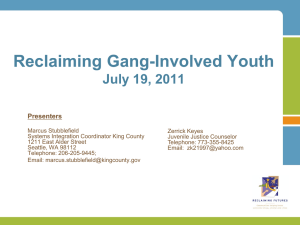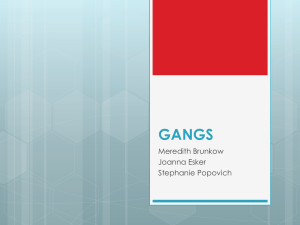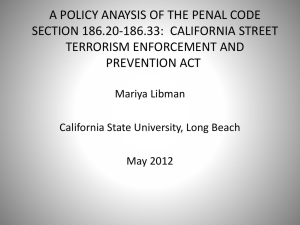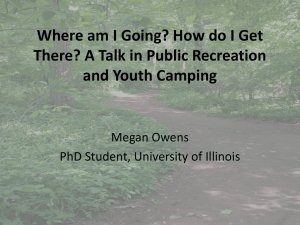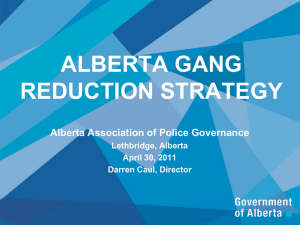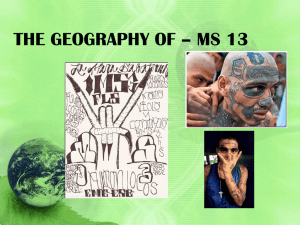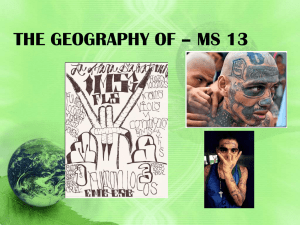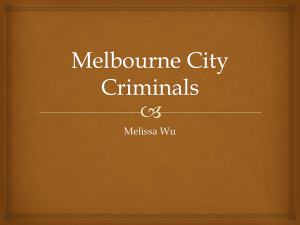Youth Gangs: - ACT for Youth
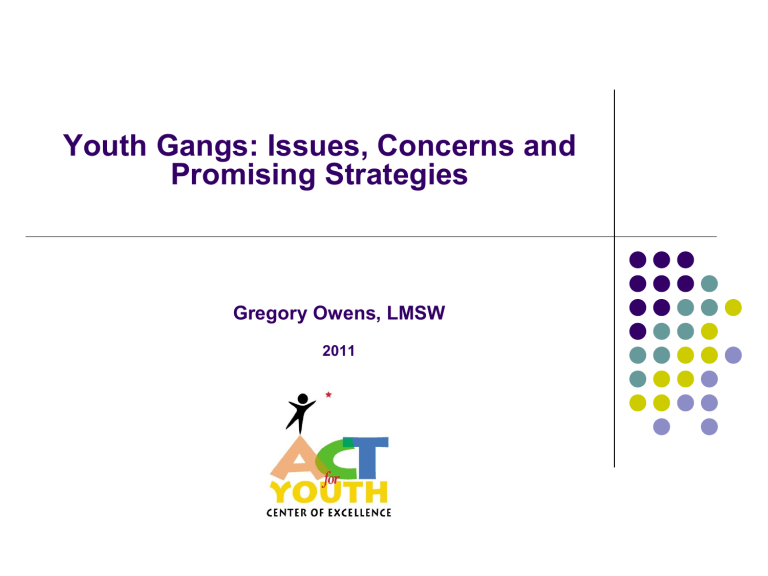
Youth Gangs: Issues, Concerns and
Promising Strategies
Gregory Owens, LMSW
2011
“The Chief Problem In Any Community Cursed
With Crime Is Not The Punishment Of
The Criminals, But The Preventing Of The
Young From Being Trained To Crime.”
-W.E.B. Du Bois-
Gregory Owens, LMSW
New York
Gang members indicted in connection with "hit" (Kingston, NY): Seven members of the Sex, Money, Murder Gang and their associates were indicted by an Ulster County grand jury on eight counts in connection with the retaliation murder of a fellow gang member, who they thought was a snitch.
Source: Mid-Hudson News Date: April 2, 2010 http://www.midhudsonnews.com/...
New York
21-year-old shot to death in Newburgh (Newburgh, NY): A 21-year-old man was shot and killed, likely for revenge, Friday night, capping a 24-hour spate of gang violence that police said was among the bloodiest in Newburgh's history.
Source: Times Herald-Record Date: March 14, 2010 http://www.recordonline.com/...
New York
Police, ATF pick up gang members (Niagara Falls, NY): Two gang members being sought in connection with the recent rash of violence in the city were picked up
Monday and Tuesday by Falls police.
Source: Niagara Gazette Date: March 17, 2010 http://niagara-gazette.com/...
http://www.nationalgangcenter.gov/Gang-Related-News
Gregory Owens, LMSW
Who Can We Learn From?
Those who successfully avoided recruitment efforts.
Those who joined and were able to get out.
Those who are still involved.
Family of all three groups!
Gregory Owens, LMSW
A brief history of gangs
A.D. 350-430 St. Augustine wrote in his confessions of the pleasure of stealing pears in the company of his adolescent accomplices: “My pleasure was not in those pears, it was in the offense itself, which the company of fellow sinners occasioned.”
Records of life in 17 th century London mention youth gangs who terrorized the citizenry by breaking windows, destroying taverns and fighting, each group wearing different colored ribbons.
www.nationalgangcenter.gov/
Gregory Owens, LMSW
National Youth Gang Center (2009). National Youth Gang Survey Analysis .
Retrieved from http://www.nationalgangcenter.gov/Survey-Analysis
Gregory Owens, LMSW
National Youth Gang Center (2009). National
Youth Gang Survey Analysis . Retrieved from http://www.nationalgangcenter.gov/Survey-
Analysis
Gregory Owens, LMSW
National Youth Gang Center (2009). National Youth Gang Survey Analysis .
Retrieved from http://www.nationalgangcenter.gov/Survey-Analysis
Gregory Owens, LMSW 8
Who are Gang Members?
“Human Beings. They are someone’s son, daughter, sister, brother, husband, wife, etc. This is a simple notion that is often forgotten. It is a key notion to treatment.”
Lisa Taylor Austin – Gang Expert at 2004 NYS Gang Summit http://www.gangcolors.com
Gregory Owens, LMSW
Elements Necessary For A Group To Be
Considered A Gang
3 or more members.
Members are generally between 12 and 24 years old.
Members share a sense of identity.
Some permanence - generally a year or more.
Criminal activity is a central element of the group.
Gregory Owens, LMSW
Theory
Klein
“Street gangs are an amalgam of racism, of urban underclass poverty, of minority and youth culture, of fatalism in the face of rampant deprivation, of political insensitivity and the gross ignorance of inner-city (and inner-town) America on the part of most of us who don’t have to survive there.”
Hagedorn, Klein and Jackson
Gangs are a product of postindustrial development.
Thrasher
Structural and community factors are important.
Delinquency/gangs are the product of social environment.
Gregory Owens, LMSW
Five Domains
Individual and Personal Attributes
Family Demographics
Peer Group
School
Community
Gregory Owens, LMSW
Individual and Family
Peers, Peer Group and School
Gregory Owens, LMSW
Community and Neighborhood
Gregory Owens, LMSW
Risk and Protective Factors
Cumulative Impact
More research needed
Gregory Owens, LMSW
Other Factors
Identity
Affiliation
Attachment
Stability
Adolescence!!
Gregory Owens, LMSW
Gangs In Schools
For Consideration
School Specific Strategies
Schools can camouflage
Gangs in schools can increase tension and the level of violence.
Gangs can increase the presence of drugs in schools.
the impact of the presence of gangs.
Schools are impacted by violence spilling over from the community.
Schools are becoming centers for gang activity.
Gangs can spread from school to school (implications for suspension, discipline and other policies).
Gregory Owens, LMSW
Target students most vulnerable to gang recruitment.
Establish mentoring programs.
Establish moral and ethical educational programs.
Offer educational programs for students about gangs.
Provide regular opportunities for students to discuss their experiences in school.
Impact Strategies
Prevention
Secondary prevention
Early intervention
Intervention
Suppression
The National Education Association
Gregory Owens, LMSW
A Schematic of Prevention, Intervention, Suppression, and Comprehensive
Programs.
Some risk (sometimes minimal) exists (e.g., local youth are at risk for joining street gangs; there is a risk for street gangs to emerge and/or grow in a particular geographic location)
Prevention Programs
Risk has manifested into an actual problem (e.g., the emergence and continuation of local street gangs; increased gang membership and violence among local youth
)
Intervention and Suppression Programs
Attempt to prevent gang membership, gang crime and/or gang emergence/growth
Tend to have a social service orientation; focus on re-integrating gang members into the community
Tend to be law enforcement based; focus on suppressing gangs and gang activity
Comprehensive Programs
These programs combine interventions and suppression techniques, as well as (at times) prevention tactics; necessitate collaboration among numerous agencies and groups.
Jean M. McGloin www.cops.usdoj.gov
Extraction/Exiting Issues
Very serious and can be dangerous
Must be done by trained and talented people
Requires a process and extensive networking
Must include family, faith and community based resources as well as law enforcement
Highly individualized and confidential strategies
Gregory Owens, LMSW
Action Steps
• Be Aware.
• Be willing to accept the truth that youth gangs exist and can be dangerous.
• Be analytical; determine the facts.
• Be open to the facts.
• Plan based upon the facts and not what you want the reality to be.
• Make this an agency/organization priority.
• Develop this as an agency initiative.
• Seek support from all staff and select youth.
• Assign a full time staff member to manage the initiative.
• Seek training from recognized expert(s).
• Include parents if possible.
Gregory Owens, LMSW
Action Steps, cont.
• Develop an agency policy about youth gangs.
• Define in specific language what “zero tolerance” means (most ZT Policies are not working).
• Include language that places a focus on prevention, intervention and community involvement .
• Learn what you need to know.
• Begin to recognize the signs of gang activity.
• Begin to look at incidents through a new lens (examine the possibility that a group incident is gang related).
Gregory Owens, LMSW
Action Steps, cont.
• Develop a forum for youth to talk about the issue.
• Make this a part of the discussion as you engage in treatment and counseling.
• Document gang activities and behaviors that happen in the program.
• Develop a database of information based on what you can document.
Gregory Owens, LMSW
Learn What You Need To Know
• Know the current recruitment methods.
• Know current initiation rituals.
• Identify areas where gangs could gain an appearance of power and control.
• Differentiate various levels of affiliation and involvement.
Gregory Owens, LMSW
OJJDP Comprehensive Gang Strategy:
One Gang Intervention Strategy
Community mobilization
Provision of academic, economic & social opportunities
Social intervention
Gang suppression
Organizational change & development
http://www.iir.com/nygc/tool/
Gregory Owens, LMSW
Closing Thoughts
There is no single clear solution to preventing or reducing gang activity.
Juveniles do not join gangs for life.
More girls are joining gangs and engaging in violent delinquent behavior.
Gangs are not solely an inner city phenomenon, or comprised of youth of color. Youth gang members come from a variety of backgrounds.
A comprehensive approach, using prevention, suppression and intervention strategies will be most effective.
Gregory Owens, LMSW
General References
Asbury, H. 1970 [1927]. The Gangs of New York: An Informal History of the
Underworld. New York: Capricorn Books.
Covey, H. C., Menard, S., & Franzese, R. J., eds. (1997). Juvenile Gangs, 2nd edition. Springfield, IL: Charles C. Thomas.
Klein, M. & Maxson, C. (2006). Street Gang Patterns and Policies. New York:
Oxford University Press.
Jankowski, M. S. (1991). Islands in the Street: Gangs and American Urban
Society. Berkeley: University of California Press.
Schneider, E. C. (1999). Vampires, Dragons, and Egyptian Kings: Youth
Gangs in Postwar New York. Princeton, NJ: Princeton University Press.
Spergel, I. A. (1990). Youth Gangs: Continuity and Change. Crime and Justice,
12.
Thrasher, F. M. (1947 [1927]). The Gang: A Study of 1,313 Gangs in Chicago.
Chicago: The University of Chicago Press.
Gregory Owens, LMSW
Resources for Action Steps
Guide to Assessing Gang Problem: http://www.nationalgangcenter.gov/Content/Documents/Assessment-
Guide/Assessment-Guide.pdf
Gang Prevention: An Overview of Research and Programs http://www.ncjrs.gov/pdffiles1/ojjdp/231116.pdf
New York Gang Investigators Association http://www.nygia.org/
History of gangs in America
National Gang Center www.nationalgangcenter.gov/
Gregory Owens, LMSW
Was this presentation useful? Please give us your feedback: http://www.zoomerang.com/Survey/WEB22AEZWMYJH3
The ACT for Youth Center of Excellence connects positive youth development resources and research to practice in New York State and beyond. The Center provides:
Technical support, training, and evaluation for youth-serving programs funded by the NYS Department of Health.
Youth Development resources: www.actforyouth.net
, publications, and narrated presentations, and the e-letter ACT for Youth Update.
Subscribe at http://www.actforyouth.net/publications/update.cfm
A home base for the ACT Youth Network. Visit the network at www.nysyouth.net
ACT for Youth Center of Excellence act4youth@cornell.edu
• 607-255-7736 • http://www.actforyouth.net
